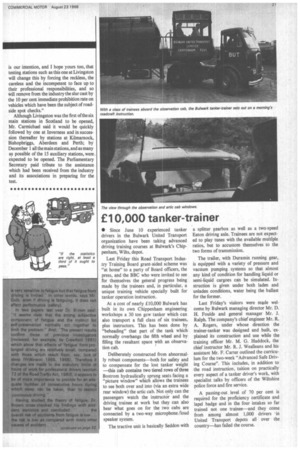Nearly two-thirds 'fail' the goods vehicle test
Page 22

Page 23

If you've noticed an error in this article please click here to report it so we can fix it.
• Of the 3,885 goods vehicles submitted for voluntary testing up to August 2 at the 30 Ministry of Transport test stations opened SO far, only 1,101 (28 per cent), were free from defects. This was revealed by Mr. Neil Carmichael, Joint Parliamentary Secretary to the Ministry, when he opened Scotland's first test station at Livingston, West Lothian, on Monday.
Of the vehicles which were found to have defects, about a third suffered from minor troubles which could be corrected quickly with simple hand tools such as a spanner or a screw-driver; a third needed replacement or repair of some parts, but the work could have been done in a simple workshop in less than a day: while a third required extensive work and replacements—and some were probably beyond economic repair.
In giving these figures, it was explained that there was great variety in the standard and category of vehicles submitted by operators for voluntary test (free tests which the Ministry is conducting in advance of the official starting date of the scheme on October 1 in England and Wales and December 1 in Scotland). Some lorries had just been overhauled in fleet workshops, while others had obviously been submitted to enable the owners to decide whether to overhaul or scrap them. But the Ministry points out that the distribution of the vehicles between these extreme conditions may not be representative of all goods vehicles now in use.
The biggest category of defects related to brakes and braking systems, which comprised 30 per cent of the total defects. Over the six-week period from June 24 to August 2, 2,458 vehicles were tested and defects were found in 1,747 of them. The following analysis of the minor and major defects found classifies them under the five sections used on the inspection card at stations. They form the basis which determines the charge for a re-test within two to 14 days after the original test:— A recent period was chosen for the analysis, to eliminate the possibility that the first tests at the first stations were not representative of routine procedures. The figure for vehicles free of defect was virtually the same in both cases, being 28 per cent for all vehicles tested and 29 per cent for those tested in the six-week period. When lie opened the Livingston station Mr. Carmichael suggested that the results might be due, in part, to the operators concerned wanting to see just how strict the Ministry tests would be. And he added: "To the extent that they are not, I hope that operators will soon appreciate the need to revise their standards of maintenance."
Mr. Carmichael described the Livingston opening as the first step on a very important new path towards an even higher degree of road safety in Scotland. Far from being a hindrance to conscientious Nei-tillers of the road transport industry, the testing stations would provide a positive assurance of mechanical efficiency and safety to the operator, driver and indeed all road users.
He went on: "There can be no doubt that over a large part of the road haulage industry, drivers are courteous and skilful, operators are efficient and demand high standards of road-worthiness from their vehicles. Nonetheless, there have been all too frequent cases in the past of lorries being sent out on to the road in a mechanically unsound and overloaded—indeed unsafe—condition. On our increasingly busy roads the attitude which leads this to be done is, at best—if we are charitable—incompetent and thoughtless, and at worst, reckless and criminal. It
is our intention, and I hope yours too, that testing stations such as this one at Livingston will change this by forcing the reckless, the careless and the incompetent to face up to their professional responsibilities, and so will remove from the industry the slur cast by the 10 per cent immediate prohibition rate on vehicles which have been the subject of roadside spot checks."
Although Livingston was the first of the six main stations in Scotland to be opened, Mr. Carmichael said it would be quickly followed by one at Inverness and in succession thereafter by stations at Kilmarnock, Bishopbriggs, Aberdeen and Perth; by December 1 all the main stations, and as many as possible of the 15 auxiliary stations, were, expected to be opened. The Parliamentary Secretary paid tribute to the assistance which had been received from the industry and its associations in preparing for the test.




















































































































